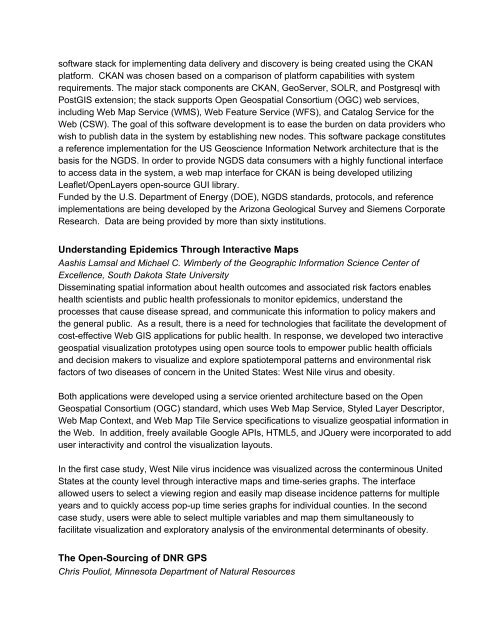FOSS4G North America Conference 2013 Preliminary Program
FOSS4G North America Conference 2013 Preliminary Program
FOSS4G North America Conference 2013 Preliminary Program
Create successful ePaper yourself
Turn your PDF publications into a flip-book with our unique Google optimized e-Paper software.
software stack for implementing data delivery and discovery is being created using the CKAN<br />
platform. CKAN was chosen based on a comparison of platform capabilities with system<br />
requirements. The major stack components are CKAN, GeoServer, SOLR, and Postgresql with<br />
PostGIS extension; the stack supports Open Geospatial Consortium (OGC) web services,<br />
including Web Map Service (WMS), Web Feature Service (WFS), and Catalog Service for the<br />
Web (CSW). The goal of this software development is to ease the burden on data providers who<br />
wish to publish data in the system by establishing new nodes. This software package constitutes<br />
a reference implementation for the US Geoscience Information Network architecture that is the<br />
basis for the NGDS. In order to provide NGDS data consumers with a highly functional interface<br />
to access data in the system, a web map interface for CKAN is being developed utilizing<br />
Leaflet/OpenLayers opensource GUI library.<br />
Funded by the U.S. Department of Energy (DOE), NGDS standards, protocols, and reference<br />
implementations are being developed by the Arizona Geological Survey and Siemens Corporate<br />
Research. Data are being provided by more than sixty institutions.<br />
Understanding Epidemics Through Interactive Maps<br />
Aashis Lamsal and Michael C. Wimberly of the Geographic Information Science Center of<br />
Excellence, South Dakota State University<br />
Disseminating spatial information about health outcomes and associated risk factors enables<br />
health scientists and public health professionals to monitor epidemics, understand the<br />
processes that cause disease spread, and communicate this information to policy makers and<br />
the general public. As a result, there is a need for technologies that facilitate the development of<br />
costeffective Web GIS applications for public health. In response, we developed two interactive<br />
geospatial visualization prototypes using open source tools to empower public health officials<br />
and decision makers to visualize and explore spatiotemporal patterns and environmental risk<br />
factors of two diseases of concern in the United States: West Nile virus and obesity.<br />
Both applications were developed using a service oriented architecture based on the Open<br />
Geospatial Consortium (OGC) standard, which uses Web Map Service, Styled Layer Descriptor,<br />
Web Map Context, and Web Map Tile Service specifications to visualize geospatial information in<br />
the Web. In addition, freely available Google APIs, HTML5, and JQuery were incorporated to add<br />
user interactivity and control the visualization layouts.<br />
In the first case study, West Nile virus incidence was visualized across the conterminous United<br />
States at the county level through interactive maps and timeseries graphs. The interface<br />
allowed users to select a viewing region and easily map disease incidence patterns for multiple<br />
years and to quickly access popup time series graphs for individual counties. In the second<br />
case study, users were able to select multiple variables and map them simultaneously to<br />
facilitate visualization and exploratory analysis of the environmental determinants of obesity.<br />
The OpenSourcing of DNR GPS<br />
Chris Pouliot, Minnesota Department of Natural Resources


